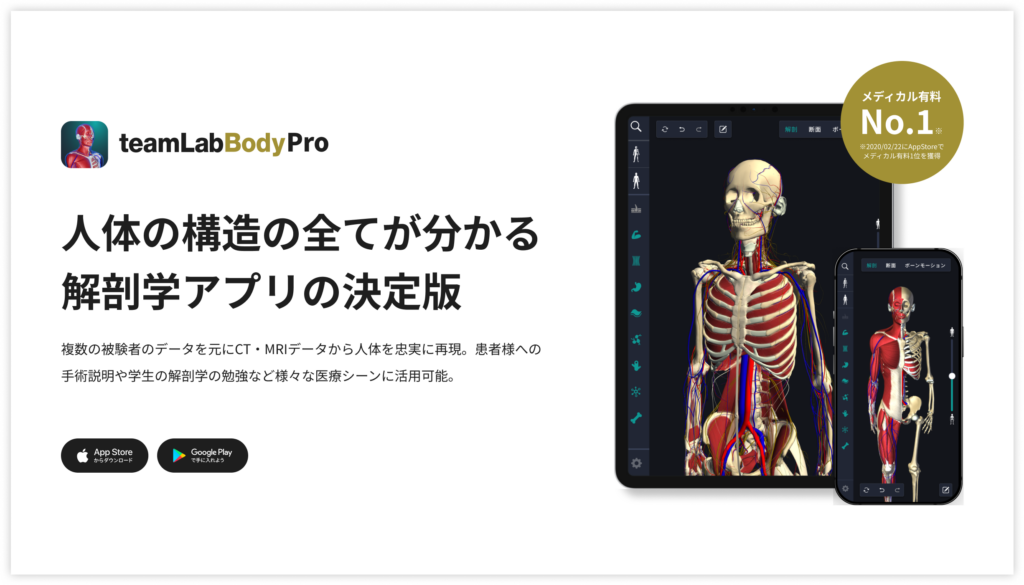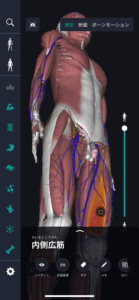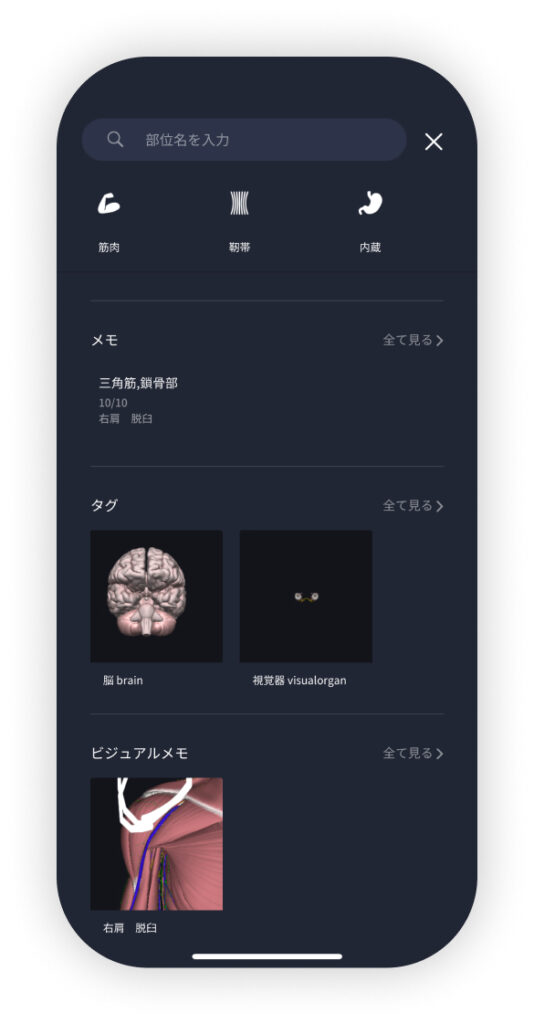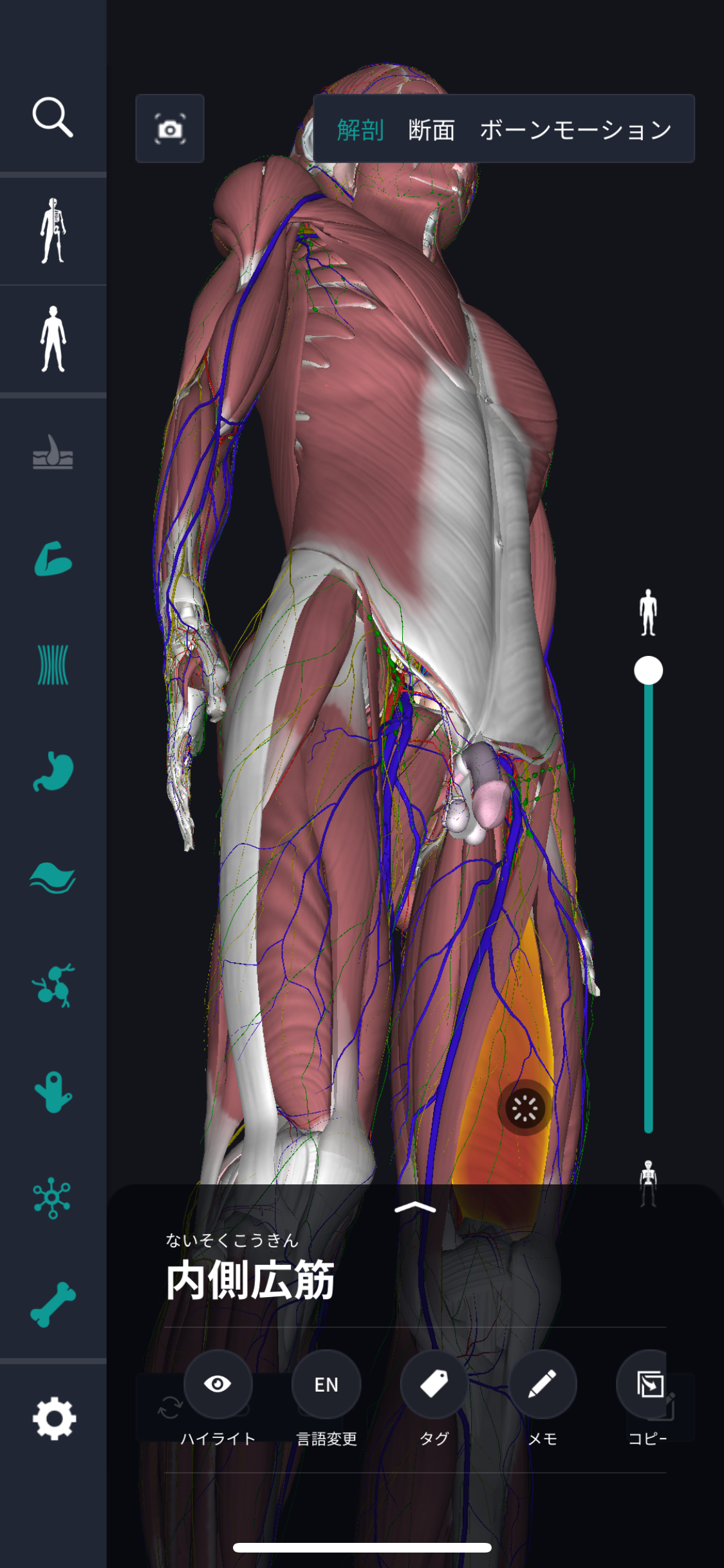beginning
In this article, I will explain effective study methods, starting with knowledge of specialized parts in human anatomy.
In human anatomy, it is necessary not only to memorize the names of various organs, muscles, and bones, but also to remember where they are located in the body. Therefore, it is necessary to learn as efficiently as possible.
I hope you can read this article and use the app to deepen your understanding even a little bit.
Now, I'll explain the details about “medial broad muscle” and how to study human anatomy.
teamLab Body Pro Free Download
A 3D anatomy app that shows all the structures of the human body
Download teamLab Body Pro here!

What is medial latissimus muscle?
In the anatomy application, you can view a selection of anatomy 3D models. In this model, there are various observation methods such as surfaces, cross-sections, and nervous systems. This time, I'll explain using an anatomy application.
About medial latissimus muscle

The medial latissimus medius muscle is one of the four muscles that make up the quadriceps femoris muscle and is located on the front of the thigh. As the name suggests, it is located inside the femur and extends from the front of the femur to the patella. This muscle is the innermost quadriceps muscle and plays a particularly important role in extending the knee joint (extending the knee). The medial medial medial muscle starts at the medial lip above the femur, attaches to the patellar bone, and reaches the rough tibial surface through the patellar tendon. The main function of this muscle is to stabilize the knee joint and properly hold the kneecap during movement. This is extremely important when extending the knee and is necessary for smooth movements when standing up and walking. The medial broad muscle contributes to controlling movement in the knee joint and helps prevent excessive knee movement. Strong muscles increase knee stability and enable smooth extension. In addition, the medial latissimus medius muscle expands the range of motion of the knee and also plays a role in properly guiding movement. The strength and flexibility of the medial latissimus muscle is also important in everyday life. When these muscles function properly, the health of the knee joint is maintained and movement efficiency is increased. The medial latissimus muscle is connected to the rough surface of the tibia through the patellar tendon, and its functional role is evident in every situation where the knee is used. Thus, the condition of this muscle directly affects the health of the knee.
Study points
Location and structure of medial latissimus muscle
The medial latissimus muscle is a muscle located on the front of the thigh and is the innermost of the four quadriceps muscles. This muscle starts at the medial lip of the femur, attaches to the patella, and reaches the rough surface of the tibia through the patellar tendon. The beginning of the medial medial medial muscle is the upper medial part of the femur, is distributed widely and flat on the femur, and converges towards the patella at its lower part to form the patellar tendon. The kneecap itself is connected to the tibia via the patellar ligament. The structure of medial broad muscle has flat muscles and abdomen, and at the top it extends all along the inside of the femur. Due to this arrangement, the medial latissimus medialis muscle provides stable support for knee movement and plays a role in keeping the kneecap in the correct position, especially during full extension of the knee joint. The thickness of the medial latissimus muscle is most prominent in its central part, and it becomes thinner as it attaches to the kneecap, but its overall width cooperates with other quadriceps femoris muscles to provide firm support. This muscle, which supports the range of motion of the knee, has constructed a complex mechanism that enables precise and controlled knee movement due to its length and breadth.
The role and function of medial latissimus muscle
The medial broad muscle plays an important role in stabilizing and extending the knee joint. Specifically, this muscle supports the movement of stretching the knee and plays a central role in smoothing movements when standing up and walking. The contraction of the medial broad muscle holds the kneecap in a normal position, and excessive movement outward is suppressed to ensure stability of the patella. This function is particularly important during full knee extension, and is involved in exercises when straightening legs and descending stairs. Furthermore, since medial broad muscle improves the accuracy of knee movement, it also plays an essential role in sports and daily life where knee stability is required. As a result, the knee is held in an optimal position, and smooth movement is possible without putting an unreasonable strain on other muscles and tissues. Strengthening the medial medial muscles promotes protection and contributes to injury prevention. Also, improving its function is useful for reducing knee pain and rehabilitation. In summary, medial broad muscle has a central function that supports range of motion and stability of the knee, and contributes to exercises requiring high function and maintaining healthy joints. The role of this muscle is emphasized in a wide range of situations, from everyday movement to sports activities.
English notation for medial vastus muscle
The medial broad muscle plays an important role in stabilizing and extending the knee joint. Specifically, this muscle supports the movement of stretching the knee and plays a central role in smoothing movements when standing up and walking. The contraction of the medial broad muscle holds the kneecap in a normal position, and excessive movement outward is suppressed to ensure stability of the patella. This function is particularly important during full knee extension, and is involved in exercises when straightening legs and descending stairs. Furthermore, since medial broad muscle improves the accuracy of knee movement, it also plays an essential role in sports and daily life where knee stability is required. As a result, the knee is held in an optimal position, and smooth movement is possible without putting an unreasonable strain on other muscles and tissues. Strengthening the medial medial muscles promotes protection and contributes to injury prevention. Also, improving its function is useful for reducing knee pain and rehabilitation. In summary, medial broad muscle has a central function that supports range of motion and stability of the knee, and contributes to exercises requiring high function and maintaining healthy joints. The role of this muscle is emphasized in a wide range of situations, from everyday movement to sports activities.
How to study human anatomy
I will explain specific study methods using human anatomy applications.
Check your past learning history and practice repeatedly
Here are the steps to check your anatomy learning history and practice iteratively effectively.
1. Check your learning history in the app
Reviewing your learning history with the application is an important step in effectively advancing anatomy learning. First, launch the app and go to the learning history section from the main menu. Many anatomy apps are designed to show your progress in the form of graphs and lists, so you can visually check which parts you've learned about and how much time you've spent.
By using this data, you can understand which areas you have strengths in and where you need to spend more time and effort. We also recommend using a dedicated tag or notebook function to mark areas you are particularly weak at or where you need to relearn. Regularly checking your learning history and looking back on past learning content will lead to efficient review and deepening understanding.
2.Make a plan for iterative learning
Making an efficient repetitive learning plan based on learning history is extremely effective in promoting knowledge retention. First, identify weak points and areas where you need to relearn. Next, arrange these study items into a weekly or monthly calendar and create a specific study schedule. By proceeding in a planned manner, you can learn each part evenly and avoid packing in a large amount of information at once.
Using a task management app or digital calendar to set study reminders is effective. Also, it's important to have the flexibility to regularly review progress and revise plans as needed. By having goals and proceeding with your studies in a planned manner, you can efficiently acquire anatomical knowledge.
3.Use 3D features to learn visually
By utilizing the 3D function, learning anatomy is easier to understand visually. The 3D model shows the structure of the human body three-dimensionally, and each part can be observed in detail. This makes it possible to intuitively grasp positional relationships between deep muscles and organs that are difficult to capture in a planar view. For example, you can learn even the smallest details by rotating specific muscles and bones and zooming in and out.
Also, there are many apps that have the function of displaying cross-sectional views of each part using a 3D model, which is useful for deepening understanding of internal structures. This diversity of visual information helps with memory retention and improves immediate responsiveness in tests and practice situations. By utilizing the 3D function and learning visually, you can learn anatomy knowledge more deeply and efficiently.
Use the memo function concretely

Make notes so you don't forget the things and points you've noticed while studying. The memo function can be used for different purposes, such as inputting text, saving images, and writing memos. Tag your notes to make them easier to review later.
Test your learning regularly in the form of quizzes
Regularly testing what you've learned in a quiz format is a very effective way to anchor your anatomy knowledge. Quiz-style tests help you objectively grasp your level of understanding and areas you lack while repeating knowledge.
For example, by using a learning app to conduct quizzes every specific period, you can reconfirm what you've learned and strengthen your memory. There are a wide range of quiz formats, such as multiple choice questions, fill-in-the-blank questions, and short answer questions, and each helps understanding from a different angle and develops the ability to utilize various types of knowledge.
Get feedback
If possible, get feedback from other learners and experts. It helps you find your own gaps in understanding and areas for improvement. You can also keep yourself motivated to learn by regularly testing yourself. Feeling a sense of accomplishment and progress increases motivation for continuous learning.
summary
This time, I explained how to study “medial broad muscle” using an application!
Thank you for reading this far.
I would be happy if reading this article helped you learn about anatomy.
Learning is a long, never-ending journey, but I sincerely wish you all the best. Let's continue to study together and work hard for the national exam!
Please look forward to the next blog.




